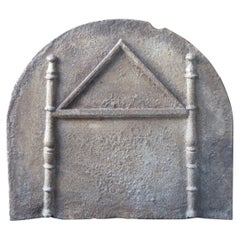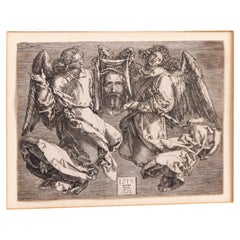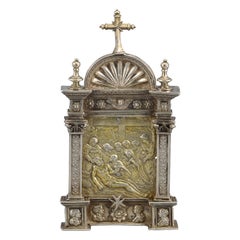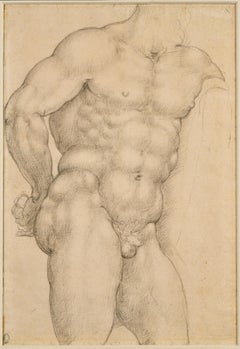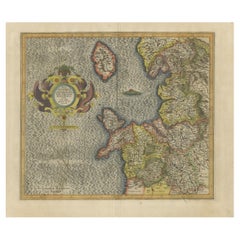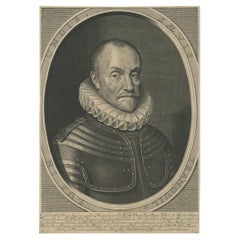Europe
to
220
1,050
519
344,919
250,342
157,900
141,067
103,907
77,239
50,746
50,135
44,030
35,270
28,316
27,362
22,597
20,017
15,994
15,584
14,771
14,161
11,708
10,745
10,469
7,581
5,838
5,751
4,978
4,403
4,320
3,593
2,819
2,606
2,116
2,114
1,941
1,554
1,471
1,278
1,191
1,136
1,005
954
932
857
716
683
523
500
393
301
281
229
220
196
195
168
165
155
115
109
99
60
45
39
68
21
6
6
3
Period: 16th Century
Period: 1620s
French Gothic Period 'Pillars and Pediment' Fireback / Backspash, 16th Century
Located in Soest, NL
16th century French Gothic Period fireback with two pillars of Hercules and a pediment.
The pillar refers to the club of Hercules, his favorite weapon. It symbolizes power. Since an...
Category
16th Century French Gothic Antique Europe
Materials
Iron
Albrecht Dürer 16th Century Old Master Engraving The Sudarium Of Saint Veronica
Located in Nottingham, GB
Albrecht Dürer 16th Century Old Master Engraving The Sudarium Of Saint Veronica
Good condition overall, framed and mounted under protective glass....
Category
16th Century Antique Europe
Materials
Paper
Silver Pax O Portapaz, Spain, 16th Century
Located in Madrid, ES
Portapaz. Silver in its color and gilded. Century XVI.
Portapaz made of silver that has a handle (decorated with delicate plant motifs similar to those of the pilasters) and a female and a male bust at the bottom, as well as other architectural elements on the back, and, on the front, an architectural composition classicist basement (with busts flanking a flower and a cross), two pilasters (vegetal decoration and capital recalling the composite order) with entablature (flowers flanking an angel's head; moldings), and a semicircular arch finish with elements veined in relief under cross and flanked by two architectural motifs in the upper part. This composition frames and enhances a gilt silver relief where you can see the Lament or Cry over the Body of Christ, with the Virgin holding the head of Jesus, Saint John at her side, the Magdalene and other characters, a cross following the group and a landscape background with houses and plant elements. This architectural structure mentioned is similar to the one present in other 16th century portapaces, such as that of the Magdalena de Dos Hermanas parish (Hernando de Ballesteros el Mozo, around 1575); or that of the Galaroza parish (same author and date); or that of the portapaz of San Miguel de Jerez de los Caballeros (in some details); etc. As for the relief, it is possible to clearly see a strong Italian influence, and the similarity between it and important pieces such as the Portapaz known as “de Cisneros by Juan de Burgos (1493-1497; MuseoCatedralicio de Alcalá de Henares), as well as in paintings and reliefs. Also noteworthy are both the male and female busts in the lower area and the Maltese cross (or Saint John's) that appears in this area. This symbol was used since the 12th century as an insignia by the Knights Hospitallers of the Order of Saint John of Jerusalem, also known as the Order of Malta...
Category
16th Century Spanish Renaissance Antique Europe
Materials
Silver
Study after Farnese Hercules
Located in Paris, Île-de-France
Study after the Farnese Hercules
Giovan Ambrogio Figino (1548-1608)
Black chalk on blue-prepared paper 33 x 23 cm
Provenance: Tajan, Drouot Paris, 23 November 2001, lot 11; Private ...
Category
16th Century Renaissance Europe
Materials
Chalk
Antique Map of England by Mercator/Hondius, circa 1600
Located in Langweer, NL
Antique map titled 'Westmorlandia, Lancastria, Caernvan, Denbigh, Flint, Merionidh, Dalopia cum issulis Mania et Anglesey'. Original antique map of England...
Category
16th Century Antique Europe
Materials
Paper
Print of William of Orange, Leader of the Dutch Revolt Against the Spanish, 1624
Located in Langweer, NL
Antique portrait of William of Orange I. With text in oval 'tranquillus in undis saevis'. Latin text below: 'Guihelmus D:G: Princeps Arausionensum; comes Nassavia, Cattimelibocii, Vianda, Dietzia, Linga, Buyra Leerdami; etc. Marchio Vera et Flissinga; dominus et baro Breda, Diest, Grimbergia, Arlay, Noseretti, Castelbellin; etc. vice comes hereditarius Antverpia et Bisancia Gubernator generalis Brabantia Hollandia Zelandia Frisia Ultrajecti Arcdithalassus maris inferioris Germania: quam celeberimi Pr: effigiem a Cornelio Vischero ad visum depictam et Guilismo Jacobi Delphio coelo hac forma expressam dedicat consecratq ipse sculptor DD: principibus Mauritio et Henrico filijs paternarum virtutum heredibus. Cum privilegio illus tr: DD : Ordinum gener. ad annos octo An. Dom'.
William the Silent (24 April 1533 – 10 July 1584), also known as William the Taciturn or, more commonly in the Netherlands, William of Orange, was the main leader of the Dutch Revolt against the Spanish Habsburgs that set off the Eighty Years' War (1568–1648) and resulted in the formal independence of the United Provinces in 1581. Born into the House of Nassau, he became Prince of Orange in 1544 and is thereby the founder of the Orange-Nassau branch and the ancestor of the monarchy of the Netherlands. In the Netherlands, he is also known as Father of the Fatherland (Pater Patriae).
A wealthy nobleman, William originally served the Habsburgs as a member of the court of Margaret of Parma, governor of the Spanish Netherlands. Unhappy with the centralisation of political power away from the local estates and with the Spanish persecution of Dutch Protestants, William joined the Dutch uprising and turned against his former masters. The most influential and politically capable of the rebels, he led the Dutch to several successes in the fight against the Spanish. Declared an outlaw by the Spanish king...
Category
1620s Antique Europe
Materials
Paper
Antique Print of the City of Groningen, The Netherlands, by Münster, c.1600
By Sebastian Münster
Located in Langweer, NL
Antique print titled 'Groeninga'. View of the city of Groningen, the Netherlands. This map originates from 'Cosmographia' published by Münster.
Artists and Engravers: Sebastian Münster...
Category
16th Century Antique Europe
Materials
Paper
16th Century English Tapestry
Located in LYON, FR
Very rare 16th Century English tapestry. Hand made my candle light over 300 years ago.
Recently professionally cleaned and in good condition.
Sources in Lyon France
Any questions p...
Category
16th Century English Medieval Antique Europe
Materials
Wool
From Paolo Veronese, Allegory of Strength and Wisdom
By Paolo Veronese
Located in Milan, IT
Follower of Paolo Veronese (Verona, 1528 - Venice, 1588)
Allegory of wisdom and strength
Oil on canvas, 48 x 36.5 cm
Picture frame, 61 x 48 cm
The Allegory of Wisdom and Strength...
Category
16th Century Other Art Style Europe
Materials
Canvas, Oil
Siege of Antwerp: Duke of Parma’s Strategic Ship Bridge over the Scheldt, 1585
Located in Langweer, NL
This engraving, titled *Pons Antverpianus Scaldi impositus*, represents the famous ship bridge constructed by the Duke of Parma over the Scheldt River during the Siege of Antwerp in ...
Category
16th Century Antique Europe
Materials
Paper
16th Century by Neapolitan Maestro Vision of Saint John in Patmos Oil on Panel
Located in Milano, Lombardia
16th Century Neapolitan Maestro
Title: Vision of Saint John in Patmos
Medium: Oil on panel
Dimensions: without frame 113 x 85 cm
Painting without frame
Expertise by Prof. Antonio Va...
Category
16th Century Old Masters Europe
Materials
Panel, Oil
Bronze Mortar, Tuscany, Second Half of 16th Century
Located in Bruxelles, BE
Bronze mortar with garlands, flowers and putti - Tuscany , second half of 17th century.
Measures: height 10
diameter : 13 cm
Artisans and healers used mortars for grinding food...
Category
16th Century Italian Renaissance Antique Europe
Materials
Bronze
Italian Renaissance Walnut Chest - 16th Century
Located in Brussels, Brussels
Superb and rare Italian Renaissance chest from the end of the 16th century in walnut
Very beautiful chest with a superb molding work on its face as well as a very beautiful base. Th...
Category
16th Century Italian Renaissance Antique Europe
Materials
Walnut
Antique Chinese Porcelain Ming Wanli China Plate Rare Decoration, 16th Century
Located in Amsterdam, Noord Holland
A very nicely decorated plate. With rare decoration. Wanli period
Additional information:
Material: Porcelain & Pottery
Region of Origin: China
Period: 16th century, 17th century Tr...
Category
16th Century Chinese Antique Europe
Materials
Porcelain
Antique Jiajing/Wanli Period Chinese Porcelain Dish Charger Floral Swatow
Located in Amsterdam, Noord Holland
Large and very nice Blue and White Charger/Dish from the Jiajin/Wanli Period.
Additional information:
Material: Porcelain & Pottery
Region of Origin: China
Emperor: Wanli (1572-1620...
Category
16th Century Chinese Ming Antique Europe
Materials
Porcelain
Exceptional Italian Renaissance Cassone with Rich Carving on a Gilt Background
Located in Saint-Ouen, FR
The lower part of the facade is adorned with a foliated and fruit garland.
The facade’s central panel bears a low-relief decor framed by a rais-de-cœur frieze. The central scene a...
Category
16th Century Italian Renaissance Antique Europe
Materials
Walnut
Antique Chinese Porcelain Ming Wanli / Tianqi Playing Go Landscape Plate
Located in Amsterdam, Noord Holland
15-7-19-1-2
Typical late Ming landscape dish. A very nice example!
Condition
Overall condition A (Very good) rimfritting, filled chip and 2 hairlines. Size 160 mm
Period...
Category
16th Century Chinese Ming Antique Europe
Materials
Porcelain
Duke of Parma’s 1585 Ship Bridge Plan: Siege of Antwerp Engineering Print
Located in Langweer, NL
This is an original engraved print from 1585, depicting the construction plans for the ship bridge built by the Duke of Parma during the Siege of Antwerp in the Eighty Years' War.
...
Category
16th Century Antique Europe
Materials
Paper
Original Antique Woodcut Map of Persia
Located in Langweer, NL
Antique map titled 'Tabula V Asiae'. Important early woodcut map of Persia, depicting the area of Mesopotamia, Armenia and the Gulf, to the Caspian and Carmania (Iran). Includes name...
Category
16th Century Antique Europe
Materials
Paper
Antique Map of the Netherlands by Guicciardini, 1582
Located in Langweer, NL
Antique map titled 'Hollandiae Cattorum Regionis Typus'. Early copper engraving of the Netherlands in the 2nd state, numbered 30 bottom right. This map originates from 'Description d...
Category
16th Century Antique Europe
Materials
Paper
Mercator's Ptolemaic map of Taprobana, (Ceylon) Sri Lanka
Located in Langweer, NL
Antique map titled 'Asiae XII Tab'. Mercator's Ptolemaic map of Taprobana. The map shows Ptolemy's erroneous location of the island of Sri Lanka near the equator, with a bit of India...
Category
16th Century Antique Europe
Materials
Paper
Damascened Steel and Gold 16th Century Box
Located in Amsterdam, NL
A beautiful box made of fire gilt and damascened steel, completely original and in mint condition, with the original key, Italy or France, 16th century.
Category
16th Century Italian Antique Europe
Materials
22k Gold, Stainless Steel, Gold, Steel
A BrutalistGothic Antique Chest
Located in Schellebelle, BE
An exceptional German Gothic, Brutalist Coffer,
very simple but strong design ,the coffer has its original Iron lock,
ideal piece of furniture to place in a modern and contemporary i...
Category
16th Century German Antique Europe
Materials
Oak
Antique Extremely Rare Judaica Tzedakah Synagoge Charity Box 16th Century
Located in Doha, QA
This 16th century Tzedakah Charity Box is an incredibly rare and unique museum quality piece. It’s made out of walnut wood and has an original 16th century silk material all over it from outside as well as in the inside, bronze plug in the front and the Star of David with two lions from the left and right side of the Star. There are also two round bronze handles to lift the box from both sides. The Tzedakah Box...
Category
16th Century Spanish Gothic Antique Europe
Materials
Metal
Ancient Course of the Ganges: A First Ptolemaic Map of India by Mercator, c.1584
Located in Langweer, NL
This remarkable map, titled "Asiae X Tab:", is a significant historical artifact that represents the convergence of knowledge and craftsmanship from two of the most esteemed figures in the history of geography and cartography.
Created by Gerard Mercator and based on the geographical insights of Claudius Ptolemy, this map is part of the rare first issue published in Brussels in 1578.
The map itself meticulously delineates the region between the Indus and Ganges rivers, an area of immense historical and geographical importance. It is an excellent representation of Ptolemy's second-century geographical data, which was fundamental in shaping the modern principles of mapmaking. Mercator, renowned for his precision and dedication to adhering closely to Ptolemy's original intentions, showcases this commitment through the detailed depiction of this significant Asian landscape.
This edition stands out not only for its historical accuracy but also for its artistic execution. Gerard Mercator, who was also an innovator in the use of the italic hand for map lettering, first introduced this style in his "Literarum latinarum" in 1540. The use of italics in this map enhances its legibility and aesthetic appeal, which became a hallmark of the finest sixteenth and seventeenth-century Dutch maps, largely attributed to Mercator’s influence.
The map measures 13 ½ x 18 inches and features fine hand coloring, which has been preserved in almost excellent condition alttough there some browning due to age. As a splendid example of the first issue from Mercator’s definitive edition of Ptolemy’s "Geographia", it not only serves as a testament to the rich history of geographical exploration but also stands as a beacon of the enduring legacy of its makers, shaping the future of cartographic design and precision.
The map "Asiae X Tab:", focusing on the region between the Indus and Ganges rivers, highlights several areas and cities of historical and geographical importance that are likely of interest to scholars, historians, and collectors. Here are key locations depicted on the map:
1. **Indus River**: As one of the major rivers of Asia and a cradle of ancient civilizations like the Indus Valley Civilization, the Indus River holds significant historical importance.
2. **Ganges River**: Another crucial river not just for its cultural and religious significance in India, but also as a vital geographic feature in ancient and medieval maps...
Category
16th Century Antique Europe
Materials
Paper
Portrait Man Pourbus 16/17th Century Paint Oil on canvas Old master Flemish
Located in Riva del Garda, IT
Frans Pourbus (Bruges, 1545 - Antwerp, 1581) circle
Portrait of a gentleman in Renaissance dress with a black doublet and ruff
Late 16th century
Oil on canvas
46 x 32 cm. - 65 x 53...
Category
16th Century Old Masters Europe
Materials
Oil
Italian Ancient Marble Sculpture Fountain, Late 16th Century
Located in Milano, IT
Sea monster
Carrara marble mouth fountain
Italy, late 16th century
It measures 13.8 x 31.5 x 18.9 in (35 x 80 x 48 cm)
State of conservation: some small evident gaps and widespread signs of wear due to outdoor exposure. The gray marks crossing it do not come from restoration, but are rather the natural veins of the marble.
This work has some morphological characteristics typically associated with the iconography of the sea monster: an elongated muzzle, sharp teeth, protruding eyes, elongated ears, and a coiled serpent's tail.
An in-depth series of studies on artistic depictions of the sea monster attempted to verify how this symbol evolved in antiquity in the European and Mediterranean contexts and how it gradually changed its image and function over time. The iconography itself is mutable and imaginative and its history is rich with cultural and artistic exchange, as well as the overlapping of ideas. This occurred so much that it is difficult to accurately pinpoint the "types" that satisfactorily represent its various developments.
However, we can try to summarize the main figures, starting from the biblical Leviathan and the marine creature that swallowed Jonah (in the Christian version, this figure was to become a whale or a "big fish", the “ketos mega”, translation of the Hebrew “dag gadol”). Other specimens ranged from the dragons mentioned in the Iliad (which were winged and had legs) to "ketos” (also from Greek mythology), the terrifying being from whose Latinized name (“cetus”) derives the word "cetacean". See J. Boardman, “Very Like a Whale” - Classical Sea Monsters, in Monsters and Demons in the Ancient and Medieval Worlds, in Papers presented in Honor of Edith Porada, Mainz am Rhein 1987, pp. 73-84).
In Italy the monster underwent yet further variations: it can be found in Etruscan art on the front of some sarcophagi representing the companion of souls, while among the Romans we find the “Pistrice” (cited by Plinio in Naturalis Historia PLIN., Nat., II 9, 8 and by Virgilio in Eneide: VERG., Aen., III, 427), which appeared in the shape of a stylized hippocampus or a very large monstrous cetacean and evolved into a hideous being with a dragon's head and long webbed fins.
During the Middle Ages, the sea monster was the object of new transformations: at this time, it is often winged, the head is stretched like a crocodile, the front legs are often very sharp fins - sometimes real paws - until the image merges with dragons, the typical figures of medieval visionary spirituality widely found throughout Europe (on this topic and much more, see: Baltrušaitis, J., Il Medioevo fantastico. Antichità ed esotismi nell’arte gotica, Gli Adelphi 1997).
In Italy during the 15th and 16th centuries, the revival of classicism - representative of the humanistic and Renaissance periods - led to a different reading of these "creatures". Indeed, the sea monster was also to find widespread use as an isolated decorative motif, especially in numerous fountains and sculptures where dolphins or sea monsters were used as a characterizing element linked to water (on this theme see: Chet Van Duzer, Sea Monsters on Medieval and Renaissance Maps, London, The British library, 2013).
From the morphological point of view, the "sea monsters" of this period are mostly depicted as hybrid figures, in which the body of a mythological or real being (a hippocampus, a sea snake, a dolphin), is joined to a head with a rather indistinct appearance. It was usually characterized by large upright ears, an elongated snout, sharp teeth and globular, protruding eyes; a complex and indefinite figure, both from the symbolic point of view and from that of its genesis.
The work we are examining is placed as a cross between the medieval sea serpent and the Renaissance dolphin, with stylistic features which recall the snake as often used in heraldry (such as the "snake" depicted in the coat of arms of the Visconti - the lords and then dukes of Milan between 1277 and 1447 - and which, for some, may be derived from the representations of the “Pistrice” that swallowed Jonah).
In the search for sources, Renaissance cartography and in particular woodcuts should not be neglected. See for example the monsters of Olaus Magnus, from the editions of the “Historia de gentibus septentrionalibus” (“History of the peoples of the north”) and the natural histories of Conrad Gesner, Ulisse...
Category
16th Century Italian Renaissance Antique Europe
Materials
Carrara Marble
Bird’s-Eye View of Basel from Braun & Hogenberg’s Civitates Orbis Terrarum, 1575
Located in Langweer, NL
Bird’s-Eye View of Basel from Braun & Hogenberg’s "Civitates Orbis Terrarum" (Circa 1572-1617)
This highly detailed map of Basel is a bird's-eye view, originally based on Sebastian Münster’s map...
Category
16th Century Antique Europe
Materials
Paper
Pre-Columbian Alabaster Sculpture – Inca Llama-Shaped Canopa
Located in Madrid, ES
Pre-Columbian alabaster sculpture – Inca Llama-shaped canopa
Dimensions: 5 x 5 x 1 cm
Small pre-Columbian ritual canopy carved in alabaster, representing a llama, a sacred animal in...
Category
16th Century Peruvian Tribal Antique Europe
Materials
Alabaster
Ecce Homo Christ Metsys 16th Century Paint Oil on table Flemish Old master
Located in Riva del Garda, IT
16th-century Flemish master
Circle of Quentin Metsys (Leuven, 1466 - Antwerp, 1530)
Ecce Homo
oil on panel
cm. 34 x 23
with frame 47 x 37 (not contemporary)
An important painting...
Category
16th Century Old Masters Europe
Materials
Oil
ANTIQUE 1622 DATED ORNATELY HAND CARVED ENGLISH OAK PAINTED THRONE ARMCHAiR
Located in West Sussex, Pulborough
Royal House Antiques
Royal House Antiques are delighted to offer for sale this absolutely stunning antique painted 1622 dated William & Mary throne armchair
Please note the delive...
Category
1620s English William and Mary Antique Europe
Materials
Oak
1579 Ornate Map of Burgundy County by Ferdinand de Lannoy
Located in Langweer, NL
1579 Ornate Map of Burgundy County by Ferdinand de Lannoy
Description of the Map:
This is a beautifully detailed map of the Burgundy region, titled "Bvrgvndiae Comitatus Recentiss....
Category
16th Century Antique Europe
Materials
Paper
Blue and White Dutch Delft Tile with Pikier, 17th Century
Located in AMSTERDAM, NH
The Netherlands
Amsterdam
Circa 1625 – 1650
A blue and white Dutch tile with a decoration of a Dutch or Spanish soldier from the period of the 80 Years War.
The decoration of this t...
Category
1620s Dutch Baroque Antique Europe
Materials
Ceramic, Faience, Majolica
School of Andrea del Sarto (Florence, 1486 - Florence, 1530), San Giovannino
By Andrea Del Sarto
Located in Milan, IT
School of Andrea del Sarto (Florence, 1486 - Florence, 1530)
Saint John
Oil on panel, 57 x 39 cm
Framed, 67 x 49 cm
The panel depicts St. John, recognizable by his staff and red ...
Category
16th Century Other Art Style Europe
Materials
Canvas, Oil
Mercator's Ptolemaic Map of the Holy Land, Cyprus and Syria, circa 1580
Located in Langweer, NL
Antique map titled 'Asiae IIII Tab'. Beautiful map of Mercator's Ptolemaic map of the Holy Land, Cyprus, Syria, etc. Originates from Mercator's 'Geograph...
Category
16th Century Antique Europe
Materials
Paper
Spanish Renaissance Period Fireplace Grate or Fire Basket, 16th Century
Located in Soest, NL
16th century Spanish Renaissance period fire grate. Made of beautifully forged wrought iron and bronze. The condition is good.
Mea...
Category
16th Century Spanish Renaissance Antique Europe
Materials
Bronze, Wrought Iron
16th Century German Gothic Fireback / Backsplash
Located in Soest, NL
16th century German gothic fireback with a religious theme. The fireback is made of cast iron and has a black patina.
This product weighs more tha...
Category
16th Century German Gothic Antique Europe
Materials
Iron
Antique Hand-Coloured Map of India, Sri Lanka, Maldives, ca.1599
Located in Langweer, NL
Title: Tabula Asiae XI - 1599
Very old and decorative map of India, Sri Lanka and the Maledives. Put this map in a frame on the wall and amaze your visitors. This original engravi...
Category
16th Century Antique Europe
Materials
Paper
Rare Cabinet depicting the Four Elements
Located in Saint-Ouen, FR
RARE CABINET DEPICTING THE FOUR ELEMENTS
ORIGIN : FRANCE
PERIOD : CIRCA 1600
Height: 178 cm
Width: 112 cm
Depth: 50 cm
Former Perpitch Collection
Forme...
Category
16th Century European Renaissance Antique Europe
Materials
Wood, Walnut
16th Century Agate Cameo Roman Charity Pendant
Located in Firenze, IT
Two-layered agate cameo, red and white, depicting Roman Charity on an amati background.
Italy, 16th century
H. 3.7 cm - L. 2.9 cm
Gold setting, eagle's head hallmark, 19th century
H....
Category
16th Century Italian Renaissance Antique Europe
Materials
Agate, 18k Gold, Yellow Gold
Italian 16th/ 17th Century Folk Art Forged Iron Coat of Arms
Located in Buisson, FR
Unique and wonderful folk art coat of arms, Depicting a eagle holding a rabbit, two crosses and two castle's and on the top a grotesque head. This beautiful period piece is made out ...
Category
16th Century Italian Folk Art Antique Europe
Materials
Iron
16-17th century Antique brass Jain shrine from India
Located in DEVENTER, NL
Antique brass Jain shrine
Material: Brass
31,5 cm high
15 cm wide and 11 cm deep
16-17th century
The naked Tirthankara modeled with broad shoulders and long arms down to the sides.
...
Category
16th Century Burmese Antique Europe
Materials
Brass
Spanish Azulejo Tile Arista y Cuenca - Toledo 16th century
By Estadio of Spain
Located in DELFT, NL
Early Arista y cuenca tile made in Toledo. Tile decorated in renaissance with stylized flowers was probably made between 1550 and 1575.
Category
16th Century Spanish Renaissance Antique Europe
Materials
Earthenware
Antique Chinese Porcelain Ming Wanli Period Plate, 1580-1600
Located in Amsterdam, Noord Holland
A very nicely decorated top level potting and top quality painted plate
Wanli period, ca 1580-1600
The scene possibly shows flowers
Additional information:
Material: Porcelain & P...
Category
16th Century Chinese Antique Europe
Materials
Porcelain
Huy (Huum) Cityscape 1574: Historical Copper Engraving by Braun & Hogenberg
Located in Langweer, NL
Title: Huum opp. condrusorum caput (...) Anno partae salutis 1574.
**Type:** Print (Colored Copper Engraving)
**Year:** Circa 1580
**Technique:** Colored Copper Engraving
**Medium:...
Category
16th Century Antique Europe
Materials
Paper
Antique English Tudor Period Oak Panel c.1590
Located in Wormelow, Herefordshire
An antique English Tudor period oak panel dating to circa 1590, deeply handcarved with three large foliage scrolls and flowers. Over 430 years old, this oak wall panel has stood the ...
Category
16th Century English Tudor Antique Europe
Materials
Wood, Oak
Small Tuscany Table from the Renaissance Period
Located in Saint-Ouen, FR
SMALL TUSCANY TABLE FROM THE RENAISSANCE PERIOD
ORIGIN : FLORENCE, ITALY
PERIOD : 16th CENTURY
Height: 69,4 cm
Length: 59,4 cm
Depth: 51 cm
...
Category
16th Century Antique Europe
Materials
Walnut
16th Century Southern Germany Wood Figure of Saint Roch
Located in Saint-Ouen, FR
Easily recognizable with his gesture of showing pest effect on his thigh this pilgrim saint is accompanied by an angel curing him. The quality of the wood is noteworthy.
Bibliography
Louis Réau, Iconographie de l’Art Chrétien...
Category
16th Century German Renaissance Antique Europe
Materials
Wood
Polidoro de' Renzi, called Polidoro da Lanciano, Mystic Marriage
Located in Milan, IT
Polidoro de' Renzi, called Polidoro da Lanciano (Lanciano, c. 1515 - Venice, 1565)
Mystic Marriage of St. Catherine
Oil on panel, 47.5 x 34.5 cm
Framed, 71 x 58 cm
The painting, ...
Category
16th Century Other Art Style Europe
Materials
Canvas, Oil
16th Century Silk Lampas Ecclesiastic Cope
By Aubusson Manufacture
Located in Canterbury, GB
Exceptionally rare antique Cope
Large and impressive
Beautiful Silk Lampas skillfully hand woven in crimson / pink silk upon an opulent gold metallic gro...
Category
16th Century Italian Renaissance Antique Europe
Materials
Metallic Thread
Spanish Renaissance Casket of the 16th Century
Located in Madrid, ES
Spanish Renaissance casket,
16th century
In carved, polychrome and gilded wood decorated with a vase with horns of plenty, heads of cherubs and fruits.
In the lock a shield with two ...
Category
16th Century Dutch Baroque Antique Europe
Materials
Wood
16th Century Cabinet with Knights Carving from Avignon Workshops 'France'
Located in Saint-Ouen, FR
Collection Jean Thuile
Around the mid-sixteenth century French furnishing evolves in its conception and ornamentation. The start of major archi...
Category
16th Century French Renaissance Antique Europe
Materials
Walnut
Original Antique Print of Huy in present day Belgium, Published circa 1580
Located in Langweer, NL
Antique print titled 'Huum Opp. Condrusorum Caput (..)'. Attractive bird’s eye view of Huy in present day Belgium. The view shows the city from the northeast. Huy, a municipality of ...
Category
16th Century Antique Europe
Materials
Paper
Saint Jerome Venetian School Paint Oil on canvas Old master 16/17th Century Art
By Jacopo Negretti, known as Palma the Younger (Venice 1544 - 1628)
Located in Riva del Garda, IT
Venetian school of the end of the 16th century
Circle of Jacopo Negretti, known as Palma the Younger (Venice 1544 - 1628)
Saint Jerome Penitent
Oil painting on canvas
85 x 64 cm. - In frame 97 x 76 cm.
This splendid painting, which offers us an intense representation of San Girolamo...
Category
16th Century Old Masters Europe
Materials
Oil
Rare and Very Old Antique Map of South East Asia, Published circa 1574
Located in Langweer, NL
A very fine impression of this map of the Malay Peninsula, Sumatra, Java, with Singapore denoted as 'Cinca Pula'.
Highly distorted and inaccurate map by Girolamo Ruscelli after J...
Category
16th Century Antique Europe
Materials
Paper
Large French Gothic Firedogs or Andirons, 16th Century
Located in Soest, NL
16th century French Gothic andirons made of wrought iron. The andirons have bull's heads and spit hooks.
These French andirons are called 'landiers' in France. This dates from the t...
Category
16th Century French Gothic Antique Europe
Materials
Wrought Iron
Antique Buddhist Alter Shrine 17-16'th Century
Located in Kastrup, DK
Rare Buddhist alter shrine, made in pine wood.
Rich on carved figural sceneries.
Original polychrome lacquer, beautiful and untouched condition.
From Shanxi Province in China.
Category
16th Century Chinese Ming Antique Europe
Materials
Pine
French Renaissance Table said "à l'italienne"
Located in Saint-Ouen, FR
Measures: Closed length : 137 cm – opened lenght : 255 cm
Beautiful table of the Second French Renaissance, said ‘à la du Cerceau’. It is in effect a model close to the projects d...
Category
16th Century French Renaissance Antique Europe
Materials
Walnut
Antique Print of Liège / Luik in Belgium by Braun & Hogenberg, 1575
Located in Langweer, NL
Antique print titled 'Leodium'. View of Liège / Luik, Belgium with surrounding hills and the city wall. With text explaining the origins of Liège, a cartouche expressing thanks to th...
Category
16th Century Antique Europe
Materials
Paper
French Renaissance Cabinet with Perspectives
Located in Saint-Ouen, FR
This Renaissance Cabinet reveals the great mastery of the Lyon workshops which are at the origin of its realization. Sculptors and wood-carvers worked here in symbiosis to express an...
Category
16th Century French Renaissance Antique Europe
Materials
Walnut
